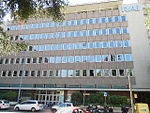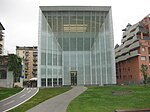PalaOnda
1993 establishments in ItalyBuildings and structures in BolzanoIndoor arenas in ItalyIndoor ice hockey venues in ItalySport in South Tyrol ... and 1 more
Sports venues completed in 1993

PalaOnda or Eiswelle, called Sparkasse Arena since 2022 for sponsorship reasons, is an indoor sports arena in Bolzano, Italy. It was built to host the 1994 Men's World Ice Hockey Championships along with Forum di Assago and has a capacity of 7,200. It is the home arena of several ice hockey teams, including HC Bolzano of the ICE Hockey League and the EVB Eagles Südtirol of the European Women's Hockey League (EWHL). The arena also hosted the 1998 European Handball Championships and the 2010–11 CEV Champions League final four.
Excerpt from the Wikipedia article PalaOnda (License: CC BY-SA 3.0, Authors, Images).PalaOnda
Via Luigi Galvani - Luigi-Galvani-Straße, Bolzano - Bozen Oltrisarco-Aslago - Oberau-Haslach
Geographical coordinates (GPS) Address External links Nearby Places Show on map
Geographical coordinates (GPS)
| Latitude | Longitude |
|---|---|
| N 46.471695 ° | E 11.329372 ° |
Address
Sparkasse Arena
Via Luigi Galvani - Luigi-Galvani-Straße 34
39100 Bolzano - Bozen, Oltrisarco-Aslago - Oberau-Haslach
Trentino-Alto Adige/Südtirol, Italy
Open on Google Maps









